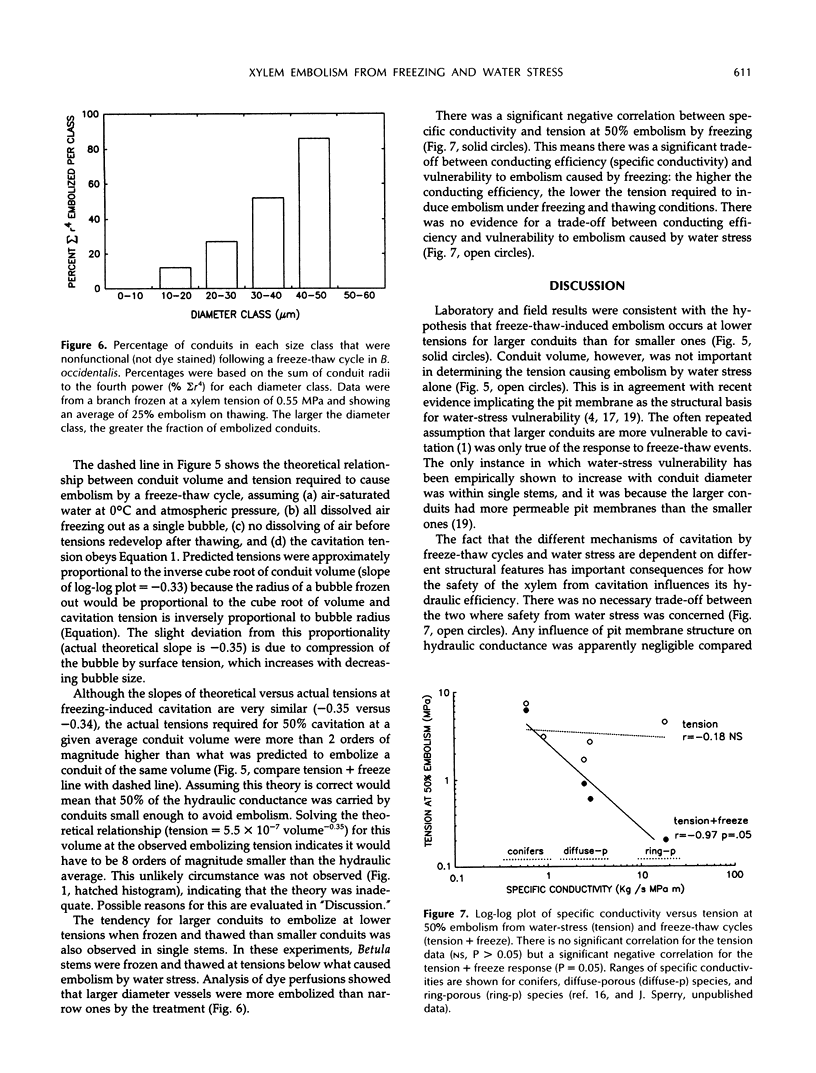Abstract
Vulnerability to xylem embolism by freeze-thaw cycles and water stress was quantified in ring-porous (Quercus gambelii Nutt.), diffuse-porous (Populus tremuloides Michx., Betula occidentalis Hook.), and conifer species (Abies lasiocarpa Nutt., Juniperus scopulorum Sarg.). Embolism was measured by its reduction of xylem hydraulic conductivity; it was induced by xylem tension (water-stress response) and by a tension plus a freeze-thaw cycle (freeze response). Conifers showed little (Juniperus) or no (Abies) freeze response even to repeated cycles. In contrast, Quercus embolized more than 90% by freezing at tensions below 0.2 MPa, whereas similar embolism without freezing required tensions above 4.5 MPa. Diffuse-porous trees (Betula, Populus) showed an intermediate freeze response. The magnitude of the freeze response was correlated with conduit volume but occurred at higher tensions than predicted from theory. Large early-wood vessels (2.8 × 10−9 m3) in oak were most vulnerable to embolism by freezing, small vessels in Populus and Betula were intermediate (approximately 7 × 10−11 m3), and tracheids in conifers (about 3 × 10−13 m3) were most resistant. The same trend was found within a stem: embolism by freeze-thawing occurred preferentially in wider conduits. The water-stress response was not correlated with conduit volume; previous work indicates it is a function of interconduit pit membrane structure. Native embolism levels during winter corroborated laboratory results on freezing: Quercus embolized 95% with the first fall freeze, Populus and Betula showed gradual increases to more than 90% embolism by winter's end, and Abies remained below 30%.
Full text
PDF








Selected References
These references are in PubMed. This may not be the complete list of references from this article.
- Cochard H., Tyree M. T. Xylem dysfunction in Quercus: vessel sizes, tyloses, cavitation and seasonal changes in embolism. Tree Physiol. 1990 Dec;6(4):393–407. doi: 10.1093/treephys/6.4.393. [DOI] [PubMed] [Google Scholar]
- Hammel H. T. Freezing of xylem sap without cavitation. Plant Physiol. 1967 Jan;42(1):55–66. doi: 10.1104/pp.42.1.55. [DOI] [PMC free article] [PubMed] [Google Scholar]
- Schultz H. R., Matthews M. A. Resistance to Water Transport in Shoots of Vitis vinifera L. : Relation to Growth at Low Water Potential. Plant Physiol. 1988 Nov;88(3):718–724. doi: 10.1104/pp.88.3.718. [DOI] [PMC free article] [PubMed] [Google Scholar]
- Sperry J. S., Tyree M. T. Mechanism of water stress-induced xylem embolism. Plant Physiol. 1988 Nov;88(3):581–587. doi: 10.1104/pp.88.3.581. [DOI] [PMC free article] [PubMed] [Google Scholar]


